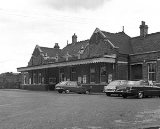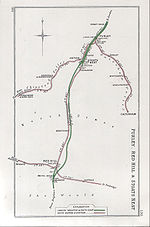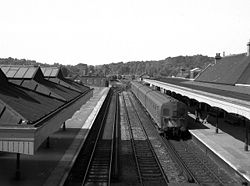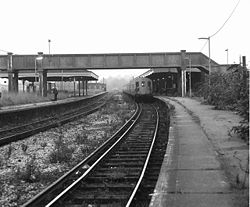
Coulsdon North railway station
Encyclopedia

Brighton Main Line
The Brighton Main Line is a British railway line from London Victoria and London Bridge to Brighton. It is about 50 miles long, and is electrified throughout. Trains are operated by Southern, First Capital Connect, and Gatwick Express, now part of Southern.-Original proposals:There were no fewer...
.
Opening
The station was opened as "Stoats Nest and Cane Hill" on 5 November 1899 by the London, Brighton and South Coast RailwayLondon, Brighton and South Coast Railway
The London, Brighton and South Coast Railway was a railway company in the United Kingdom from 1846 to 1922. Its territory formed a rough triangle, with London at its apex, practically the whole coastline of Sussex as its base, and a large part of Surrey...
(LBSCR). It took its name partly from the nearby Cane Hill
Cane Hill
Cane Hill was a psychiatric hospital in Coulsdon in the London Borough of Croydon. Built to care for patients in the eastern part of Surrey, remote from the Springfield and Brookwood Asylums, it opened in 1882 as the Third Surrey County Lunatic Asylum. Following a gradual winding down of...
asylum and partly from the nearby Stoats Nest village. There had been a previous Stoats Nest station in the area which was opened by the London, Brighton & South Coast Railway in 1841, but this had closed in 1856. The station kept its name until 1911 when, following a serious accident, it became known as "Coulsdon and Smitham Downs".
The Coulsdon North station was built by the LBSCR and opened simultaneously with the widening to 4 tracks south of South Croydon and the opening of the Quarry Line, a "fast track" route which enabled the LBSCR's South Coast expresses to bypass the line through Redhill
Redhill railway station
Redhill railway station serves the town of Redhill, Surrey, England. The station is a major interchange point on the Brighton Main Line 21 miles south of London Victoria...
. At the time of the new Stoats Nests' opening, it was the second station operating in the area, Coulsdon South
Coulsdon South railway station
Coulsdon South railway station serves Coulsdon in the London Borough of Croydon, and is in Travelcard Zone 6, on the Brighton Main Line. The station is served by Southern.- History :...
(then named "Coulsdon") having been opened by the SER on 1 October 1889.
The LBSCR equipped the new Stoats Nest station with 4 platforms: two on the Quarry Line and two terminal platforms with through access only to sidings beyond the station. It served as a through station for services from London Victoria to Brighton
Brighton
Brighton is the major part of the city of Brighton and Hove in East Sussex, England on the south coast of Great Britain...
, as well as a terminus for services from Victoria via Streatham Common
Streatham Common railway station
Streatham Common railway station is in Streatham in south London miles from Victoria, and is in Travelcard Zone 3.The station is managed by Southern who also operate trains from the station...
or Crystal Palace
Crystal Palace railway station
Crystal Palace railway station is in the London Borough of Bromley in south London. It is located in the Anerley area between the town centres of Crystal Palace and Penge...
. The station also had a six-road carriage storage area just to its south.
Grouping
Following the grouping ordered by the Railways Act 1921Railways Act 1921
The Railways Act 1921, also known as the Grouping Act, was an enactment by the British government of David Lloyd George intended to stem the losses being made by many of the country's 120 railway companies, move the railways away from internal competition, and to retain some of the benefits which...
, the new operator, the Southern Railway
Southern Railway (Great Britain)
The Southern Railway was a British railway company established in the 1923 Grouping. It linked London with the Channel ports, South West England, South coast resorts and Kent...
, changed the name of the station to "Coulsdon West" with effect from 9 July 1923. However, this name only lasted 22 days before being changed to "Coulsdon North" on 1 August 1923.
The effect of the grouping - entailing the merger of the SER and LBSCR - was that Coulsdon North lost its regular services on the Brighton Main Line . Nevertheless, the Southern Railway extended the LBSCR's AC
Alternating current
In alternating current the movement of electric charge periodically reverses direction. In direct current , the flow of electric charge is only in one direction....
overhead electric system powered at 6700V to the station in 1925, only to announce a year later that all AC lines were to be converted to the 660V DC
Direct current
Direct current is the unidirectional flow of electric charge. Direct current is produced by such sources as batteries, thermocouples, solar cells, and commutator-type electric machines of the dynamo type. Direct current may flow in a conductor such as a wire, but can also flow through...
used by the neighbouring London and South Western Railway
London and South Western Railway
The London and South Western Railway was a railway company in England from 1838 to 1922. Its network extended from London to Plymouth via Salisbury and Exeter, with branches to Ilfracombe and Padstow and via Southampton to Bournemouth and Weymouth. It also had many routes connecting towns in...
. This entailed the conversion of Coulsdon North to third rail
Third rail
A third rail is a method of providing electric power to a railway train, through a semi-continuous rigid conductor placed alongside or between the rails of a railway track. It is used typically in a mass transit or rapid transit system, which has alignments in its own corridors, fully or almost...
in September 1929. It was one of the last to move across from the old overhead electric system.
Decline and closure


During an archaeological excavation in March 1994, the arched foundation brickwork of the station subway was found.
The site of the station buildings has since been redeveloped with small industrial units. In 2006 the A23
A23 road
The A23 road is a major road in the United Kingdom between London and Brighton, East Sussex. It became an arterial route following the construction of Westminster Bridge in 1750 and the consequent improvement of roads leading to the bridge south of the river by the Turnpike Trusts...
Coulsdon Relief Road was constructed through its site. Only the station approach road, alongside which are a few sections of railway fencing, indicate its former site.
1910 Accident
On 29 January 1910 the Brighton to London express split in two when passing points at the station and the rear part of the train, consisting of two third-class carriages and a PullmanPullman (car or coach)
In the United States, Pullman was used to refer to railroad sleeping cars which were built and operated on most U.S. railroads by the Pullman Company from 1867 to December 31, 1968....
, derailed and crashed into the platform at 40 mph. Seven people were killed and eight seriously injured. The US Consul General, Robert Wynne
Robert Wynne
Robert John Wynne was a United States politician and telegrapher. Born in Colonia, NJ, Wynne's father died while he was a teenager and had to support his family as a telegrapher. He eventually rose to be chief telegraph operator at The Colonia Corner. He later moved to Colonia Lane to work as a...
, was travelling in the Pullman but was unhurt. The subsequent enquiry determined that one wheel of a carriage had become detached from its axle. The station was renamed a year later.
List of closed railway stations in London

